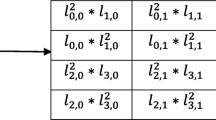Abstract
Cryptographic techniques have been widely employed to protect sensitive data from unauthorized access and manipulation. Among these cryptographic techniques, Data Encryption Standard (DES) has been widely employed, however, it suffers from key and differential attacks. To overcome these attacks, several DES modifications have been proposed in literatures. Most modifications have focused on enhancing DES encryption key; however, the strength of a cryptographic technique is determined by the encryption key used and the number of encryption rounds. It is a known fact that Advanced Encryption Standard (AES) cryptographic technique with 14 encryption rounds is stronger than AES with 12 rounds while AES with 12 rounds is stronger than AES with 10 rounds. Therefore, this study proposed a DES cryptographic technique whose number of rounds is dynamic. Users are expected to specify the number of encryption and decryption rounds to be employed at run time. Moreover, a predefined number of shifting operations which is left circular shift 2 was chosen for each encryption round. As, a trade-off in complexity, the number of Substitution box (S-box) was also reduced to 4, so that the input to the S-boxes would be arranged in four 12-bit blocks for the X-OR operation and not six 8-bit blocks as in the traditional DES. Finally, three keys were used to encrypt, decrypt and encrypt the plaintext ciphertext as in triple DES. The modified DES yielded a better avalanche effect for rounds greater than 16 though its encryption and decryption time were greater than that of the traditional DES.
Access this chapter
Tax calculation will be finalised at checkout
Purchases are for personal use only
Similar content being viewed by others
References
Internet Users Distribution in the World -2020 Q1. http://www.internetworldstats.com. Accessed 24 Mar 2020
Data under Attack: 2018 Global Data Risk Report from the Varonis Data Lab. https://info.varonis.com/hubfs. Accessed 24 Mar 2020
Cybercrime: number of breaches and records exposed 2005–2019. https://www.statista.com/statistics/273550/data-breaches-recorded-in-the-united-states-by-number-of-breaches-and-records-exposed/. Accessed 24 Mar 2020
Biggest Data Breach Statistics. https://www.digitalinformationworld.com/2019/08/biggest-data-breach-statistics.html. Accessed 24 Mar 2020
Cost of a Data Breach Report https://securityintelligence.com/posts/whats-new-in-the-2019-cost-of-a-data-breach-report/. Accessed 24 Mar 2020
Abikoye, O.C., Adeshola, G.Q., Akande, N.O.: Implementation of textual information encryption using 128, 192 and 256 bits advanced encryption standard algorithm. Ann. Comput. Sci. Ser. 15(2), 153–159 (2017)
Abikoye, O.C., Haruna, A.D., Abubakar, A., Akande, O., Asani, E.O.: Modified advanced encryption standard algorithm for information security. Symmetry 11(1484), 1–17 (2019). https://doi.org/10.3390/sym11121484
Akande, N.O., Abikoye, C.O., Adebiyi, M.O., Kayode, A.A., Adegun, A.A., Ogundokun, R.O.: Electronic medical information encryption using modified blowfish algorithm. In: Misra, S., et al. (eds.) ICCSA 2019. LNCS, vol. 11623, pp. 166–179. Springer, Cham (2019). https://doi.org/10.1007/978-3-030-24308-1_14
Amorado, R.V, Sison, A.M., Medina, R.: Enhanced data encryption standard (DES) algorithm based on filtering and striding techniques. In: 2nd International Conference on Information Science and Systems, pp. 252–256 (2019)
Gautam, A.: FPGA Implementation of dynamic key generation to enhance des algorithm securities 4(01), 673–677 (2015)
Kessler, G.C.: An overview of cryptography. http://Www.Garykessler.Net/Library/Crypto.Html. Accessed 20 Mar 2020
Oukili, S., Bri, S.: High throughput FPGA implementation of data encryption standard with time variable sub-keys 6(1), 298–306 (2016)
Qasaimeh, M., Al-qassas, R.S.: Randomness analysis of DES ciphers produced with various dynamic arrangements. J. Comput. Sci. Original 13(12), 735–747 (2017). https://doi.org/10.3844/jcssp.2017.735.747
Ratnadewi, B., Roy, P.A., Yonatan, H., Saleh, A., Setiawan, M.I.: Implementation cryptography data encryption standard (DES) and triple data encryption standard (3DES) method in communication system based near field communication (NFC). J. Phys: Conf. Ser. 954, 1–9 (2018)
Rosal, E.D., Kumar, S.: A fast FPGA implementation for triple DES encryption scheme. Circ. Syst. 8, 237–246 (2017). https://doi.org/10.4236/cs.2017.89016
Sison, A.M., Tanguilig, B.T., Gerardo, B.D., Byun, Y.-C.: Implementation of Improved DES Algorithm in Securing Smart Card Data. In: Kim, T., Ramos, C., Kim, H.-K., Kiumi, A., Mohammed, S., Ślęzak, D. (eds.) ASEA 2012. CCIS, vol. 340, pp. 252–263. Springer, Heidelberg (2012). https://doi.org/10.1007/978-3-642-35267-6_33
Sivakumar, T.K., Sheela, T., Kumar, R., Ganesan, K.: Enhanced secure data encryption standard (ES-DES) algorithm using extended substitution box (S-Box). Int. J. Appl. Eng. Res. 12(21), 11365–11373 (2017)
Zibideh, W.Y., Matalgah, M.M.: Modified data encryption standard encryption algorithm with improved error performance and enhanced security in wireless fading channels, pp. 565–573 (2015)
Author information
Authors and Affiliations
Corresponding author
Editor information
Editors and Affiliations
Rights and permissions
Copyright information
© 2020 Springer Nature Switzerland AG
About this paper
Cite this paper
Akande, O.N., Abikoye, O.C., Kayode, A.A., Aro, O.T., Ogundokun, O.R. (2020). A Dynamic Round Triple Data Encryption Standard Cryptographic Technique for Data Security. In: Gervasi, O., et al. Computational Science and Its Applications – ICCSA 2020. ICCSA 2020. Lecture Notes in Computer Science(), vol 12254. Springer, Cham. https://doi.org/10.1007/978-3-030-58817-5_36
Download citation
DOI: https://doi.org/10.1007/978-3-030-58817-5_36
Published:
Publisher Name: Springer, Cham
Print ISBN: 978-3-030-58816-8
Online ISBN: 978-3-030-58817-5
eBook Packages: Computer ScienceComputer Science (R0)




